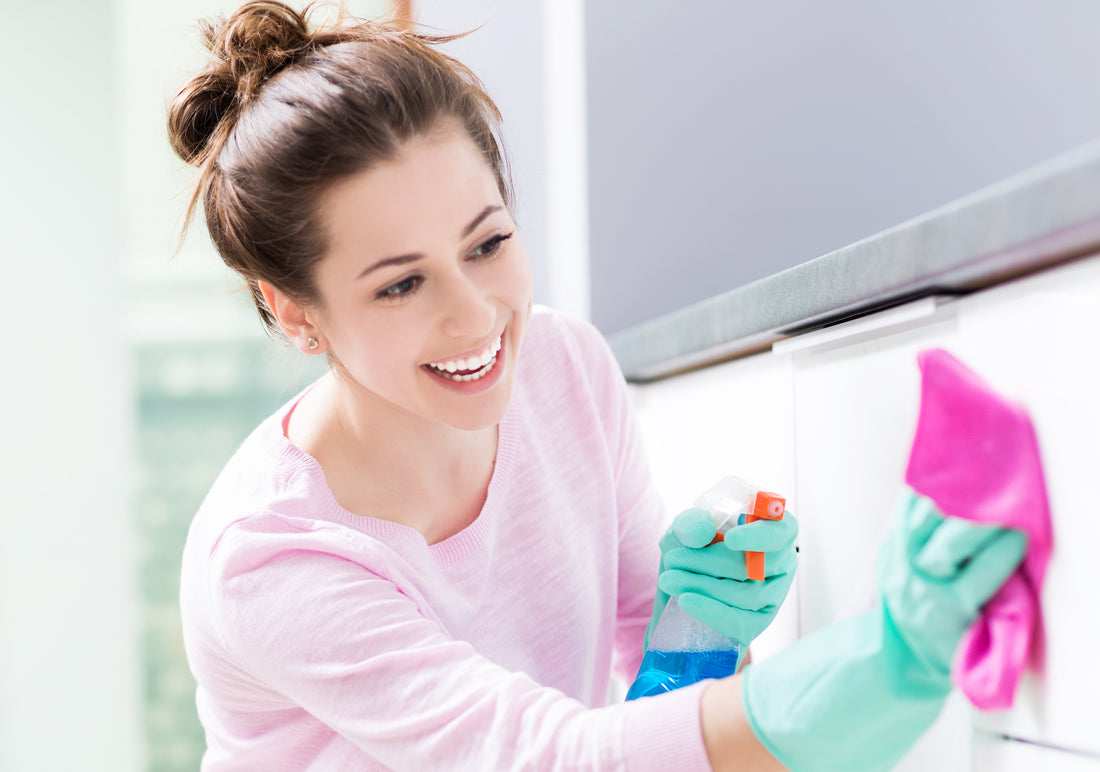HOW DO YOU KNOW IF A CLEANING PRODUCT IS HARMFUL?

Reviewing labels on conventional cleaning products is simple.
There is no ingredient list! While all ingredients must be listed on labels of skin and body care products, there is no federal regulation of chemicals in household cleaning products.
There is no safety standard and no requirement for listing of ingredients. Many of these products are required to be disposed of at a hazardous waste facility and can cause injury if handled improperly – they pose a threat not only to people, but the environment as well. Furthermore, there are many “non-toxic” and “natural” products available that are biodegradable and environmentally safe, however, it is not enough to use those label claims as a reason to keep a product. Many have their own toxic red flag ingredients and may have potential for harm.
HERE’S WHAT TO LOOK FOR:
Many essential oils are processed with solvents that have harmful VOCs, so botanical fragrances should be wildcrafted or organic and not processed with solvents.
Studies have found that terpenes in pine, lemon, and orange oils react with ozone from outside air to create secondary toxic compounds such as formaldehyde, acetaldehyde, acetone, and ultrafine particles in the indoor air. Avoid use on Ozone Alert Days.
+ UNSCENTED PRODUCTS
Even conventional products labeled as “unscented” or “free and clear” can contain masking agents that are added to simply cover up fragrance with another toxic chemical. Always look for an ingredient list and not just the unscented claim.
+ PETROLEUM BASED INGREDIENTS
An ending of “ol” or “ene” is likely an indication of a petroleum-based product or coal tar derivative (i.e. xylol, glycol, phenol, benzene, toulene, xylene).
+ PRESERVATIVES*
- Some of the most popular cleaning products that claim to be non-toxic actually have antibacterial ingredients that are EPA-registered pesticides used as preservatives from the isothiazoline family such as MIT (methylisothiazolinone) and BIT (benzisothiazolinone) which are known skin irritants and are considered neurotoxic.
- Phenoxyethanol-preservative found in “non-toxic” cleaning products - an endocrine disruptor, neurotoxin, skin and eye irritant; phenoxyethanol is an ethoxylated compound that may be contaminated with the carcinogenic toxin 1,4-Dioxane.
- Potassium sorbate - preservative associated with skin and eye irritation.
- Sodium benzoate - preservative that has been associated with eye irritation, asthma, and can form benzene, a potent carcinogen, in the presence of Vitamin C.
*Although preservatives are usually only included in very small amounts, research shows they can actually do more harm on the delicate hormone system than large amounts. The dose does not always make the poison.
+ SURFACTANTS
Dig into your non-toxic products and find out what surfactants are used. Naturally-derived synthetic surfactants used in many non-toxic cleaners are made from plant-based ingredients such as coconut oil. Even though made from plants the processing steps make them synthetic. Unfortunately, many of these naturally-derived synthetic surfactants are very toxic to aquatic life, are known carcinogens, have toxic byproducts such as 1-4 dioxane and nitrosamine, and are rated very high as a skin irritant. The exceptions are the alkyl glucosides - coco glucoside, lauryl glucoside, and decyl glucoside - which are EU (European Union) Cosmetic Directive approved for skin, body, and baby care, have no carcinogens or toxic byproducts and are biodegradable.
FOR ANY OTHER INGREDIENT IN QUESTION GO TO:
- MADESAFE Hazard List of Chemicals, Materials and Ingredients.
- EWG’s Skin Deep Cosmetics Database - search each ingredient. The ingredients are rated 1 -10 -with 1 being the safest to 10 being the most toxic.
- Think Dirty® App. Just scan the product barcode and Think Dirty will give you easy-to-understand info on the product and its ingredients! We recommend that your cleaning products have all ingredients rated a 1 or 2 on EWG’s Skin Deep Database, or a zero on Think Dirty.
REMOVE ALL HARMFUL CLEANING PRODUCTS
Take this step seriously as chemicals escape even through closed lids. Think about the strong smell of chemicals when you go down the grocery store aisle that has cleaning products and pesticides. Those bottles are not only closed but also sealed and yet the chemicals still emit from the containers. The same thing happens in our homes as most of us have products throughout the house under sinks, in closets, drawers, laundry rooms and attached garages. They create a low level chemical soup that is harmful to health. The presence of these toxic chemicals, even in small amounts, can undermine health and the body’s ability to heal. Having a few products here and there hijacks the intention to establish your home as a safe haven. Replace your toxic products with natural based products.
We encourage you to view this as an opportunity to take proactive, preventative care of your family’s health! It costs no money to remove these products from inside your home and will likely save money in the long run with reduced doctor visits and medications. Know that every single item you remove will result in an improvement in your home’s air quality, and thus your family’s health! We’ve seen it happen time and time again!
Sonny Hobbs,
Culleoka Company
Owner, Principal

